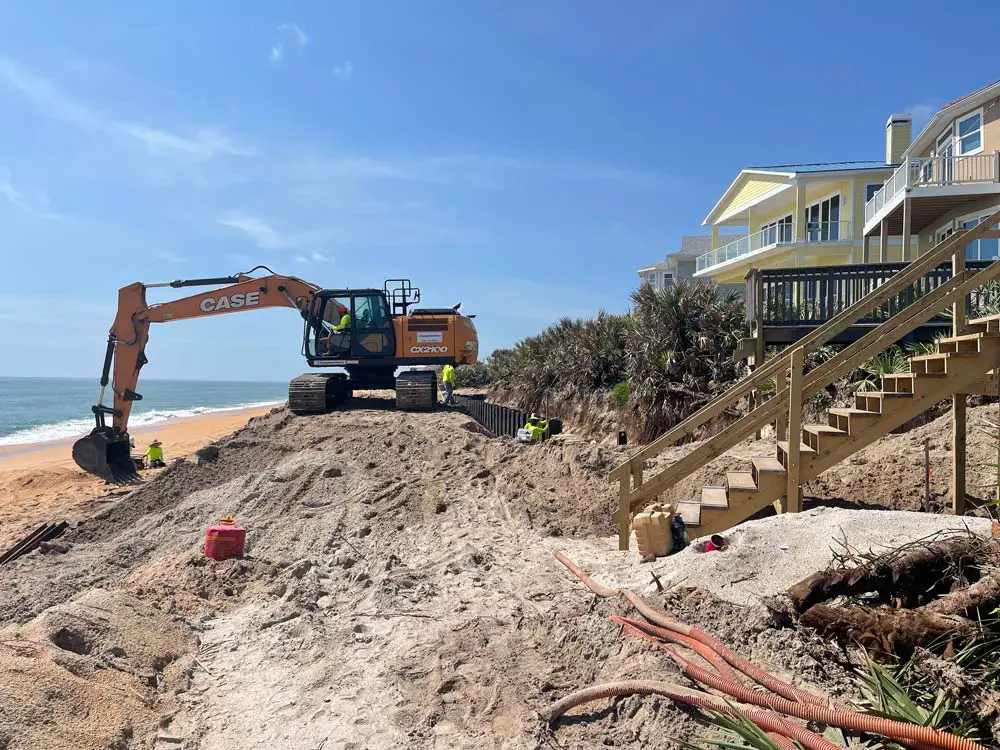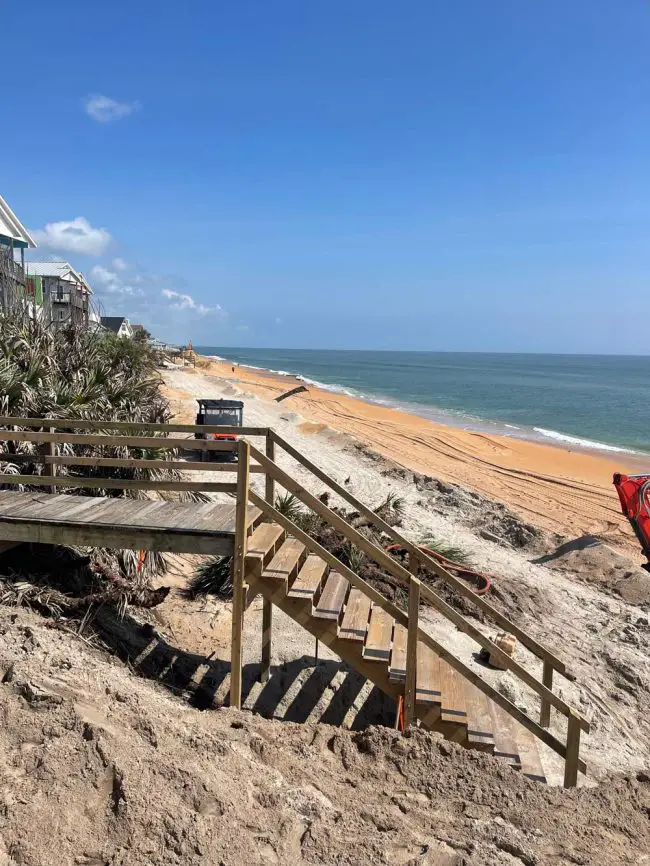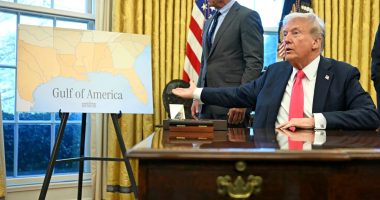
Jason Wiles, a 43-year-old resident of Oceanshore Boulevard in Flagler Beach, was arrested on a felony battery charge after he allegedly beat up a 68-year-old man in a dispute over the man’s use of a beach walkover on Tuesday.
The dispute takes place amid a larger context involving residents around the walkover and a seawall several beachside homeowners are building–a seawall Wiles opposes, and against which he has filed an administrative challenge with the Department of Environmental Protection.
In another wrinkle, Wiles is married to Ronni Moore, an assistant county attorney in Flagler County government–the office that since 2016 has been at the forefront of the county’s efforts to protect beaches through dune-rebuilding and the securing of easements from homeowners to make large-scale beach-renourishment possible. Moore was not involved in the incident, other than Wiles calling her to let her know it happened.
The seawall–a secant seawall of the type several clusters of homeowners are building or have completed along the same stretch of shore, which has been ravaged by erosion since Hurricane Matthew in 2016–was permitted by the Department of Environmental Protection in Aril. The department issued its conditional permit to Port Orange-based Dredging and Marine Consultant to build the 192-foot seawall on April 24. A DEP notice to “proceed at will” followed on May 8, and construction started.
Wiles, however–according to Michael Lambert, his attorney on the criminal matter–worried that the construction would undermine the integrity of the walkway. On May 30, Jake Varn, the seasoned Tallahassee-based land use attorney representing Wiles on that score, filed a petition with DEP for an administrative hearing that required all work to stop pending a final determination by the state agency. The agency in turn issued a notification letter to the contractor ordering a work stoppage.
Work stopped–not right away, but by mid-June. According to a summary of what followed by Varn, he and Silvia Alderman, the attorney representing the homeowners seeking the seawall, worked toward a settlement, and did so rather swiftly. But Varn then learned that work had resumed on the seawall, even though no resolution had been signed. In fact, Alderman was now proposing a different settlement.
The resumption of the work was what Lambert described as “the catalyst” of the incident that took place on Tuesday.
Notably, however, there is no connexion, other than contextual, between a civil issue and a criminal act. In court, Wiles will not be able to argue–nor will a judge be interested in hearing–that, because he was upset over the work resuming on the seawall, his alleged assault on another man was somehow explicable. Judges take a justifiably dim view of such rationales.

The incident is nevertheless illustrative of a new kind of tension and dynamics that are now part of beachside norms as recurring consequences of rising seas erode more than just shorelines: the fabric of beachside culture is also fraying.
In mid-afternoon on July 18, a resident contacted 911 to say that Wiles was “being verbally aggressive with employees and residents while also making the statement that he would beat people up,” according to Wiles’s arrest affidavit. The caller, identified as Waldtraut Chavez, 58, of 3309 North Oceanshore Boulevard, called 911 again seven minutes later to report that “things just became physical” and attacked another neighbor, a 68-year-old man called Joe. The report states Joe recovering from recent spinal fusion surgery. Wiles himself called 911 at 4 p.m. to report that he had been “attacked wand was forced to punch [Joe] to get away.”
The incident took place on or near the walkover between the house owned by Tommy Tant (the retired school district finance director) to the north and that owned by Stanley Tavanese Sr. and Waldtraut to the south.
The walkover and the sliver of land it’s on is privately owned by three parties who live in adjacent properties across the street: Wiles and Moore own 50 percent, Michael Hutcheson owns 25 percent, and Christopher Bishop owns 25 percent. Notably, Flagler County owns the beachside land adjoining the walkway to its south and for the length of four properties, up to 3294 North Oceanshore, where the county has ownership of its own sliver of land, where it could build a public walkover that theoretically would make moot most disputes over private walkover use.
Read Related Also: The Supreme Court Killed Student Loan Forgiveness. Here’s What’s Next.
Unlike privately owned beaches in front of oceanside houses, which may be freely used by the public under Flagler County’s cutomary use ordinance, private walkovers may not be so freely used, unless their owner or owners give permission. In this case, Joe and neighbors claim he had permission to use the walkover from one of the three owners.

According to the account Tavanese gave Flagler County Sheriff’s deputies, Wiles had walked from across the streety to the walkover and started yelling at the workers working on the seawall. Tavanese walked to his second-story balcony overlooking the scene and told Wiles to stop. About then, Joe walked over to get to the beach by way of the walkover. Tavanese told the deputy that Joe had permission from one of the three homeowners to use the walkover whenever he liked.
Wiles–according to Tavanese’s account–told Joe that the walkover was closed. The two men got in each other’s faces, and Wiles “suddenly and without warning struck [Joe] in the face with a closed fist,” according to the affidavit. Tavanese ran around the house to stop Wiles. By the time he got to Joe, Wiles was walking back to his own house.
The deputy’s report describes Joe as having “several lacerations including on his leg and face. I was advised he also had a large hematoma the back of his head.” Joe’s wife transported him to the hospital.
Wiles told the deputy that workers at the site were not supposed to carry out any construction until the litigation was complete, so he confronted the workers and took pictures for his attorney. As he was doing so, Joe “entered the walkway behind him, and he felt threatened,” according to the affidavit. Joe, he told the deputy, continued to approach him “aggressively,” they got in each other’s faces, and Joe allegedly chest-bumped him twice.
Wiles showed a picture that he said proved Joe was in his face. “All that was seen in the photo was [Joe] standing approximately 3 feet in from” Wiles, the deputy reported. Wiles said he felt entrapped by Joe on one side and the workers on the other, and was afraid they would attack him, though the deputy, again in a note of skepticism, reported that surveillance footage showed no employees “ever standing on the walkway during the incident.”
Wiles told the deputy he had tried to de-escalate the situation. He said he punched Joe in self-defense as Wiles was attempting to leave the walkway, but he was unsure how many times he punched him, or whether he continued to do so after Joe had fallen to the ground. There were scuff marks on Wiles’s knees, “consistent with kneeling on the ground.” Wiles was unsure where those marks came from. The deputy appears not to have gotten a satisfactory explanation of the way Wiles attempted to pass by Joe. “It should be noted,” the deputy wrote, “after later analyzing the walkway itself, there is ample room for two adults to walk side by side.”
The deputy added: Wiles “was reminded of his claim that he was trying to de-escalate and was in fear of being attacked. He was asked if that was true, how could he have time to call two people, and take a photo, but never make any attempt to call law enforcement. [Wiles] was unable to answer.”
None of the home-based surveillance cameras captured the totality of the confrontation, showing only that no one had entered the walkway behind Wiles as it went on. A doorbell camera that starts after the confrontation ended and is partially obstructed shows Joe on the floor along the walkway, with Wiles standing over him, waving his arms around in apparent anger, then walking away, turning around and “continuing his tirade.”
He then turns around, grabs Joe’s phone, and hurls it toward State Road A1A. Again the deputy notes with skepticism that in the footage Wiles “is closer to the beach, while [Joe] is closer to the street. This directly contradicts any claim that [Wiles] made that the physical altercation was a result of him trying to get home.”
Battery is a first degree misdemeanor. Battery of a person 65 or older is a third-degree felony. Wiles was booked at the county jail on $10,000, which he posted. Circuit Judge Terence Perkins signed a no-contact order, barring Wiles from having any contact with the victim or the witnesses.
Meanwhile the Wiles civil petition regarding the seawall is on its way to the division of administrative hearings as Varn, his attorney, attempts to stop the work on the seawall. “I am interested in finding out what actions, if any, DEP intends to take in this matter,” Varn wrote Cameron Berton, an assistant general counsel at DEP. “Should DEP decide not to stop the work by the contractor and responds to our requests, we would appreciate it very much as we may take some other legal action to stop the contractor’s illegal work.”
Wiles was complimentary of his attorney’s approach: “You have a gift of being able to show authority and intensity without aggression,” Wiles wrote Varn early this morning in an email–a gift that appears to have eluded Wiles on Tuesday.










